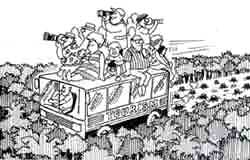When opposite poles attract
 TOURISM is often in conflict with conservation and, because tourism is often detrimental to natural resources, conservationists view the relationship between the two with a degree of unhappiness. There could, however, be a situation where tourism and conservation are organised so that both benefit from the relationship. This means that while natural assets are conserved as far as possible in their original condition, an increasing number of people derive wider benefits from nature and natural resources.
TOURISM is often in conflict with conservation and, because tourism is often detrimental to natural resources, conservationists view the relationship between the two with a degree of unhappiness. There could, however, be a situation where tourism and conservation are organised so that both benefit from the relationship. This means that while natural assets are conserved as far as possible in their original condition, an increasing number of people derive wider benefits from nature and natural resources.
In recent years, there has been a virtual boom in the tourism industry, especially in connection with wildlife and protected areas. There has also been a substantial increase in the proportion of the population that is conditioned to enjoy better incomes, improved communication facilities, cheaper travel and expanded and improved accommodation facilities.
Tourism is on the rise throughout the world and is unavoidably affecting the resources on which it is based. The irony is that those who handle tourism must be educated enough to recognise the dangers and conservationists should be made to understand that tourism, rather than being stopped, must be better planned and controlled.
Complicated task
Interfering with the physical setting of a natural area is a complicated task. The location and construction of hotels and roads need very careful planning and should involve consultations with ecologists and people who manage the parks. The latter should have a clear understanding of the present and future requirements of tourism.
Past experience clearly shows that most former projections of the impact of tourism were inaccurate, particularly in those countries where nature-based tourism has increased dramatically. All too often there had been no assessment, because the value of keeping natural areas as much in their original state as possible was not recognised. Now the situation is changing and in some protected areas, for example in the Jim Corbett national park in Uttar Pradesh, buildings that had been erected for accommodating tourists are being shifted from the reserve area, motor traffic is being controlled, and the impact of tourism is being reduced. The aim is not so much to limit the flow of visitors as to redistribute them in space and time.
As a general rule, it is most advisable to have hotels and recreation centres situated outside the natural area, and to provide some kind of an information and interpretation centre at the entrance.
Tourism and conservation can benefit mutually from each other. Tourism helps by lending support to conservation programmes that will develop educational, scientific and recreational resources, which, in turn, will attract more tourists. There are as yet only a few cases where this has actually been achieved, but the potential is immense.
TOURISM is often in conflict with conservation and, because tourism is often detrimental to natural resources, conservationists view the relationship between the two with a degree of unhappiness. There could, however, be a situation where tourism and conservation are organised so that both benefit from the relationship. This means that while natural assets are conserved as far as possible in their original condition, an increasing number of people derive wider benefits from nature and natural resources.
In recent years, there has been a virtual boom in the tourism industry, especially in connection with wildlife and protected areas. There has also been a substantial increase in the proportion of the population that is conditioned to enjoy better incomes, improved communication facilities, cheaper travel and expanded and improved accommodation facilities.
Tourism is on the rise throughout the world and is unavoidably affecting the resources on which it is based. The irony is that those who handle tourism must be educated enough to recognise the dangers and conservationists should be made to understand that tourism, rather than being stopped, must be better planned and controlled.
Complicated task
Interfering with the physical setting of a natural area is a complicated task. The location and construction of hotels and roads need very careful planning and should involve consultations with ecologists and people who manage the parks. The latter should have a clear understanding of the present and future requirements of tourism.
Past experience clearly shows that most former projections of the impact of tourism were inaccurate, particularly in those countries where nature-based tourism has increased dramatically. All too often there had been no assessment, because the value of keeping natural areas as much in their original state as possible was not recognised. Now the situation is changing and in some protected areas, for example in the Jim Corbett national park in Uttar Pradesh, buildings that had been erected for accommodating tourists are being shifted from the reserve area, motor traffic is being controlled, and the impact of tourism is being reduced. The aim is not so much to limit the flow of visitors as to redistribute them in space and time.
As a general rule, it is most advisable to have hotels and recreation centres situated outside the natural area, and to provide some kind of an information and interpretation centre at the entrance.
Tourism and conservation can benefit mutually from each other. Tourism helps by lending support to conservation programmes that will develop educational, scientific and recreational resources, which, in turn, will attract more tourists. There are as yet only a few cases where this has actually been achieved, but the potential is immense.
